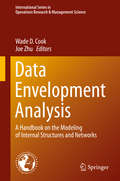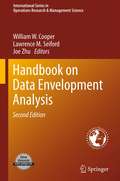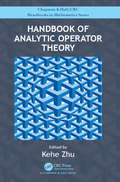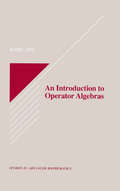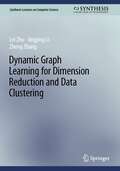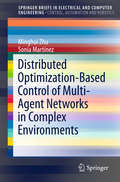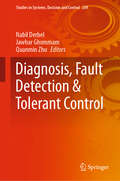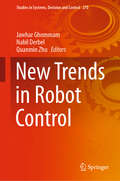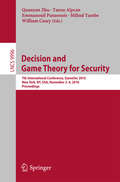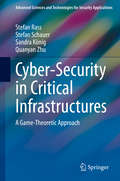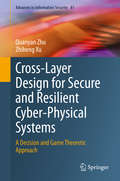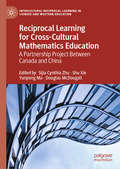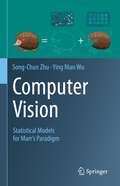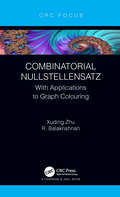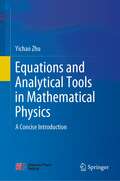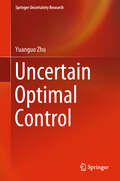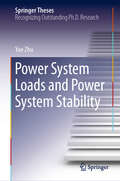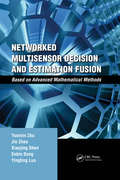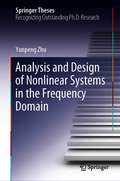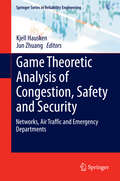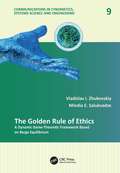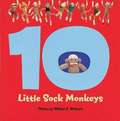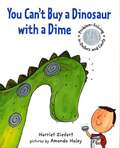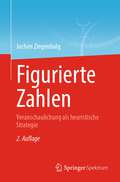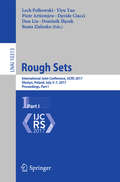- Table View
- List View
Data Envelopment Analysis: A Handbook of Modeling Internal Structure and Network (International Series in Operations Research & Management Science #208)
by Joe Zhu Wade D. CookThis handbook serves as a complement to the Handbook on Data Envelopment Analysis (eds, W. W. Cooper, L. M. Seiford and J, Zhu, 2011, Springer) in an effort to extend the frontier of DEA research. It provides a comprehensive source for the state-of-the art DEA modeling on internal structures and network DEA. Chapter 1 provides a survey on two-stage network performance decomposition and modeling techniques. Chapter 2 discusses the pitfalls in network DEA modeling. Chapter 3 discusses efficiency decompositions in network DEA under three types of structures, namely series, parallel and dynamic. Chapter 4 studies the determination of the network DEA frontier. In chapter 5 additive efficiency decomposition in network DEA is discussed. An approach in scale efficiency measurement in two-stage networks is presented in chapter 6. Chapter 7 further discusses the scale efficiency decomposition in two stage networks. Chapter 8 offers a bargaining game approach to modeling two-stage networks. Chapter 9 studies shared resources and efficiency decomposition in two-stage networks. Chapter 10 introduces an approach to computing the technical efficiency scores for a dynamic production network and its sub-processes. Chapter 11 presents a slacks-based network DEA. Chapter 12 discusses a DEA modeling technique for a two-stage network process where the inputs of the second stage include both the outputs from the first stage and additional inputs to the second stage. Chapter 13 presents an efficiency measurement methodology for multi-stage production systems. Chapter 14 discusses network DEA models, both static and dynamic. The discussion also explores various useful objective functions that can be applied to the models to find the optimal allocation of resources for processes within the black box, that are normally invisible to DEA. Chapter 15 provides a comprehensive review of various type network DEA modeling techniques. Chapter 16 presents shared resources models for deriving aggregate measures of bank-branch performance, with accompanying component measures that make up that aggregate value. Chapter 17 examines a set of manufacturing plants operating under a single umbrella, with the objective being to use the component or function measures to decide what might be considered as each plant's core business. Chapter 18 considers problem settings where there may be clusters or groups of DMUs that form a hierarchy. The specific case of a set off electric power plants is examined in this context. Chapter 19 models bad outputs in two-stage network DEA. Chapter 20 presents an application of network DEA to performance measurement of Major League Baseball (MLB) teams. Chapter 21 presents an application of a two-stage network DEA model for examining the performance of 30 U. S. airline companies. Chapter 22 then presents two distinct network efficiency models that are applied to engineering systems.
Handbook on Data Envelopment Analysis
by Joe Zhu William W. Cooper Lawrence M. SeifordThis handbook covers DEA topics that are extensively used and solidly based. The purpose of the handbook is to (1) describe and elucidate the state of the field and (2), where appropriate, extend the frontier of DEA research. It defines the state-of-the-art of DEA methodology and its uses. This handbook is intended to represent a milestone in the progression of DEA. Written by experts, who are generally major contributors to the topics to be covered, it includes a comprehensive review and discussion of basic DEA models, which, in the present issue extensions to the basic DEA methods, and a collection of DEA applications in the areas of banking, engineering, health care, and services. The handbook's chapters are organized into two categories: (i) basic DEA models, concepts, and their extensions, and (ii) DEA applications. First edition contributors have returned to update their work. The second edition includes updated versions of selected first edition chapters. New chapters have been added on: different approaches with no need for a priori choices of weights (called "multipliers) that reflect meaningful trade-offs, construction of static and dynamic DEA technologies, slacks-based model and its extensions, DEA models for DMUs that have internal structures network DEA that can be used for measuring supply chain operations, Selection of DEA applications in the service sector with a focus on building a conceptual framework, research design and interpreting results.
Handbook of Analytic Operator Theory (CRC Press/Chapman and Hall Handbooks in Mathematics Series)
by Kehe ZhuHandbook of Analytic Operator Theory thoroughly covers the subject of holomorphic function spaces and operators acting on them. The spaces covered include Bergman spaces, Hardy spaces, Fock spaces and the Drury-Averson space. Operators discussed in the book include Toeplitz operators, Hankel operators, composition operators, and Cowen-Douglas class operators. <P><P>The volume consists of eleven articles in the general area of analytic function spaces and operators on them. Each contributor focuses on one particular topic, for example, operator theory on the Drury-Aversson space, and presents the material in the form of a survey paper which contains all the major results in the area and includes all relevant references. The overalp between this volume and existing books in the area is minimal. The material on two-variable weighted shifts by Curto, the Drury-Averson space by Fang and Xia, the Cowen-Douglas class by Misra, and operator theory on the bi-disk by Yang has never appeared in book form before. <P><P>Features: <li>The editor of the handbook is a widely known and published researcher on this topic <li>The handbook's contributors are a who's=who of top researchers in the area <li>The first contributed volume on these diverse topics
An Introduction to Operator Algebras (Studies in Advanced Mathematics #9)
by Kehe ZhuAn Introduction to Operator Algebras is a concise text/reference that focuses on the fundamental results in operator algebras. Results discussed include Gelfand's representation of commutative C*-algebras, the GNS construction, the spectral theorem, polar decomposition, von Neumann's double commutant theorem, Kaplansky's density theorem, the (continuous, Borel, and L8) functional calculus for normal operators, and type decomposition for von Neumann algebras. Exercises are provided after each chapter.
Dynamic Graph Learning for Dimension Reduction and Data Clustering (Synthesis Lectures on Computer Science)
by Lei Zhu Jingjing Li Zheng ZhangThis book illustrates how to achieve effective dimension reduction and data clustering. The authors explain how to accomplish this by utilizing the advanced dynamic graph learning technique in the era of big data. The book begins by providing background on dynamic graph learning. The authors discuss why it has attracted considerable research attention in recent years and has become well recognized as an advanced technique. After covering the key topics related to dynamic graph learning, the book discusses the recent advancements in the area. The authors then explain how these techniques can be practically applied for several purposes, including feature selection, feature projection, and data clustering.
Distributed Optimization-Based Control of Multi-Agent Networks in Complex Environments
by Minghui Zhu Sonia MartínezThis book offers a concise and in-depth exposition of specific algorithmic solutions for distributed optimization based control of multi-agent networks and their performance analysis. It synthesizes and analyzes distributed strategies for three collaborative tasks: distributed cooperative optimization, mobile sensor deployment and multi-vehicle formation control. The book integrates miscellaneous ideas and tools from dynamic systems, control theory, graph theory, optimization, game theory and Markov chains to address the particular challenges introduced by such complexities in the environment as topological dynamics, environmental uncertainties, and potential cyber-attack by human adversaries. The book is written for first- or second-year graduate students in a variety of engineering disciplines, including control, robotics, decision-making, optimization and algorithms and with backgrounds in aerospace engineering, computer science, electrical engineering, mechanical engineering and operations research. Researchers in these areas may also find the book useful as a reference.
Diagnosis, Fault Detection & Tolerant Control (Studies in Systems, Decision and Control #269)
by Quanmin Zhu Nabil Derbel Jawhar GhommamThis book focuses on unhealthy cyber-physical systems. Consisting of 14 chapters, it discusses recognizing the beginning of the fault, diagnosing the appearance of the fault, and stopping the system or switching to a special control mode known as fault-tolerant control. Each chapter includes the background, motivation, quantitative development (equations), and case studies/illustration/tutorial (simulations, experiences, curves, tables, etc.). Readers can easily tailor the techniques presented to accommodate their ad hoc applications.
New Trends in Robot Control (Studies in Systems, Decision and Control #270)
by Quanmin Zhu Nabil Derbel Jawhar GhommamThis book presents solutions to control problems in a number of robotic systems and provides a wealth of worked-out examples with full analytical and numerical details, graphically illustrated to aid in reader comprehension. It also presents relevant studies on and applications of robotic system control approaches, as well as the latest findings from interdisciplinary theoretical studies. Featuring chapters on advanced control (fuzzy, neural, backstepping, sliding mode, adaptive, predictive, diagnosis, and fault-tolerant control), the book will equip readers to easily tailor the techniques to their own applications. Accordingly, it offers a valuable resource for researchers, engineers, and students in the field of robotic systems.
Decision and Game Theory for Security
by Quanyan Zhu Tansu Alpcan Emmanouil Panaousis Milind Tambe William CaseyThis book constitutes the refereed proceedings of the 6th International Conference on Decision and Game Theory for Security, GameSec 2015, held in London, UK, in November 2015. The 16 revised full papers presented together with 5 short papers were carefully reviewed and selected from 37 submissions. Game and decision theory has emerged as a valuable systematic framework with powerful analytical tools in dealing with the intricacies involved in making sound and sensible security decisions. For instance, game theory provides methodical approaches to account for interdependencies of security decisions, the role of hidden and asymmetric information, the perception of risks and costs in human behaviour, the incentives/limitations of the attackers, and much more. Combined with our classical approach to computer and network security, and drawing from various fields such as economic, social and behavioural sciences, game and decision theory is playing a fundamental role in the development of the pillars of the "science of security".
Cyber-Security in Critical Infrastructures: A Game-Theoretic Approach (Advanced Sciences and Technologies for Security Applications)
by Quanyan Zhu Stefan Rass Stefan Schauer Sandra KönigThis book presents a compendium of selected game- and decision-theoretic models to achieve and assess the security of critical infrastructures. Given contemporary reports on security incidents of various kinds, we can see a paradigm shift to attacks of an increasingly heterogeneous nature, combining different techniques into what we know as an advanced persistent threat. Security precautions must match these diverse threat patterns in an equally diverse manner; in response, this book provides a wealth of techniques for protection and mitigation. Much traditional security research has a narrow focus on specific attack scenarios or applications, and strives to make an attack “practically impossible.” A more recent approach to security views it as a scenario in which the cost of an attack exceeds the potential reward. This does not rule out the possibility of an attack but minimizes its likelihood to the least possible risk. The book follows this economic definition of security, offering a management scientific view that seeks a balance between security investments and their resulting benefits. It focuses on optimization of resources in light of threats such as terrorism and advanced persistent threats. Drawing on the authors’ experience and inspired by real case studies, the book provides a systematic approach to critical infrastructure security and resilience. Presenting a mixture of theoretical work and practical success stories, the book is chiefly intended for students and practitioners seeking an introduction to game- and decision-theoretic techniques for security. The required mathematical concepts are self-contained, rigorously introduced, and illustrated by case studies. The book also provides software tools that help guide readers in the practical use of the scientific models and computational frameworks.
Cross-Layer Design for Secure and Resilient Cyber-Physical Systems: A Decision and Game Theoretic Approach (Advances in Information Security #81)
by Quanyan Zhu Zhiheng XuThis book introduces a cross-layer design to achieve security and resilience for CPSs (Cyber-Physical Systems). The authors interconnect various technical tools and methods to capture the different properties between cyber and physical layers. Part II of this book bridges the gap between cryptography and control-theoretic tools. It develops a bespoke crypto-control framework to address security and resiliency in control and estimation problems where the outsourcing of computations is possible. Part III of this book bridges the gap between game theory and control theory and develops interdependent impact-aware security defense strategies and cyber-aware resilient control strategies.With the rapid development of smart cities, there is a growing need to integrate the physical systems, ranging from large-scale infrastructures to small embedded systems, with networked communications. The integration of the physical and cyber systems forms Cyber-Physical Systems (CPSs), enabling the use of digital information and control technologies to improve the monitoring, operation, and planning of the systems. Despite these advantages, they are vulnerable to cyber-physical attacks, which aim to damage the physical layer through the cyber network.This book also uses case studies from autonomous systems, communication-based train control systems, cyber manufacturing, and robotic systems to illustrate the proposed methodologies. These case studies aim to motivate readers to adopt a cross-layer system perspective toward security and resilience issues of large and complex systems and develop domain-specific solutions to address CPS challenges.A comprehensive suite of solutions to a broad range of technical challenges in secure and resilient control systems are described in this book (many of the findings in this book are useful to anyone working in cybersecurity). Researchers, professors, and advanced-level students working in computer science and engineering will find this book useful as a reference or secondary text. Industry professionals and military workers interested in cybersecurity will also want to purchase this book.
Reciprocal Learning for Cross-Cultural Mathematics Education: A Partnership Project Between Canada and China (Intercultural Reciprocal Learning in Chinese and Western Education)
by Sijia Cynthia Zhu Shu Xie Yunpeng Ma Douglas McDougallThis edited volume examines new ways of teaching mathematics through a cross-cultural reciprocal learning project between sister schools in Canada and China. Situating teacher learning in the intersection of the two different school systems, curriculums, and cultures of mathematics learning and teaching in both nations, this volume offers teachers a unique and much-needed perspective on how practices between countries become more and more likely shaped by each other in the emerging global society. Born out of a comparative study project sponsored by the SSHRC, this volume compiles five years' worth of findings from reciprocal partnerships between researchers, teachers, school administrators, and students from both nations. Through the process of reciprocal learning and narrative inquiry, the research described in these chapters illuminates the unknown and shares newly-created mathematics education knowledge.
Computer Vision: Statistical Models for Marr's Paradigm
by Song-Chun Zhu Ying Nian WuAs the first book of a three-part series, this book is offered as a tribute to pioneers in vision, such as Béla Julesz, David Marr, King-Sun Fu, Ulf Grenander, and David Mumford. The authors hope to provide foundation and, perhaps more importantly, further inspiration for continued research in vision. This book covers David Marr's paradigm and various underlying statistical models for vision. The mathematical framework herein integrates three regimes of models (low-, mid-, and high-entropy regimes) and provides foundation for research in visual coding, recognition, and cognition. Concepts are first explained for understanding and then supported by findings in psychology and neuroscience, after which they are established by statistical models and associated learning and inference algorithms. A reader will gain a unified, cross-disciplinary view of research in vision and will accrue knowledge spanning from psychology to neuroscience to statistics.
Combinatorial Nullstellensatz: With Applications to Graph Colouring
by Xuding Zhu R. BalakrishnanCombinatorial Nullstellensatz is a novel theorem in algebra introduced by Noga Alon to tackle combinatorial problems in diverse areas of mathematics. This book focuses on the applications of this theorem to graph colouring. A key step in the applications of Combinatorial Nullstellensatz is to show that the coefficient of a certain monomial in the expansion of a polynomial is nonzero. The major part of the book concentrates on three methods for calculating the coefficients: Alon-Tarsi orientation: The task is to show that a graph has an orientation with given maximum out-degree and for which the number of even Eulerian sub-digraphs is different from the number of odd Eulerian sub-digraphs. In particular, this method is used to show that a graph whose edge set decomposes into a Hamilton cycle and vertex-disjoint triangles is 3-choosable, and that every planar graph has a matching whose deletion results in a 4-choosable graph. Interpolation formula for the coefficient: This method is in particular used to show that toroidal grids of even order are 3-choosable, r-edge colourable r-regular planar graphs are r-edge choosable, and complete graphs of order p+1, where p is a prime, are p-edge choosable. Coefficients as the permanents of matrices: This method is in particular used in the study of the list version of vertex-edge weighting and to show that every graph is (2,3)-choosable. It is suited as a reference book for a graduate course in mathematics.
Equations and Analytical Tools in Mathematical Physics: A Concise Introduction
by Yichao ZhuThis book highlights a concise and readable introduction to typical treatments of partial differential equations in mathematical physics. Mathematical physics is regarded by many as a profound discipline. In conventional textbooks of mathematical physics, the known and the new pieces of knowledge often intertwine with each other. The book aims to ease readers' struggle by facilitating a smooth transition to new knowledge. To achieve so, the author designs knowledge maps before each chapter and provides comparative summaries in each chapter whenever appropriate. Through these unique ways, readers can clarify the underlying structures among different equations and extend one's vision to the big picture. The book also emphasizes applications of the knowledge by providing practical examples. The book is intended for all those interested in mathematical physics, enabling them to develop a solid command in using partial differential equations to solve physics and engineering problems in a not-so-painful learning experience.
Uncertain Optimal Control (Springer Uncertainty Research Ser.)
by Yuanguo ZhuThis book introduces the theory and applications of uncertain optimal control, and establishes two types of models including expected value uncertain optimal control and optimistic value uncertain optimal control. These models, which have continuous-time forms and discrete-time forms, make use of dynamic programming. The uncertain optimal control theory relates to equations of optimality, uncertain bang-bang optimal control, optimal control with switched uncertain system, and optimal control for uncertain system with time-delay. Uncertain optimal control has applications in portfolio selection, engineering, and games. The book is a useful resource for researchers, engineers, and students in the fields of mathematics, cybernetics, operations research, industrial engineering, artificial intelligence, economics, and management science.
Power System Loads and Power System Stability (Springer Theses)
by Yue ZhuThis thesis develops a pioneering methodology and a concept for identifying critical loads and load model parameters in large power networks based on their influence on power system stability. The research described in the thesis first develops an automatic load modelling tool (ALMT) that can be used to automatically build load model from actual measured power system data without human intervention and the benefits of the ALMY are explored. Secondly, it develops a pioneering framework based on Morris screening method for ranking power system load model parameters based on their influence on overall power system stability (voltage, frequency, transient and small disturbance stability) considering different load models and loading conditions. Thirdly, a novel probabilistic methodology for determining the accuracy levels of critical load model parameters has been developed. This book will be of interest to students and researchers within the field of electrical engineering, as well as industry professionals.
Networked Multisensor Decision and Estimation Fusion: Based on Advanced Mathematical Methods
by Yunmin Zhu Jie Zhou Xiaojing Shen Enbin Song Yingting LuoDue to the increased capability, reliability, robustness, and survivability of systems with multiple distributed sensors, multi-source information fusion has become a crucial technique in a growing number of areas-including sensor networks, space technology, air traffic control, military engineering, agriculture and environmental engineering, and i
Analysis and Design of Nonlinear Systems in the Frequency Domain (Springer Theses)
by Yunpeng ZhuThis book focuses on the development of three novel approaches to build up a framework for the frequency domain analysis and design of nonlinear systems. The concepts are derived from Volterra series representation of nonlinear systems which are described by nonlinear difference or differential equations. Occupying the middle ground between traditional linear approaches and more complex nonlinear system theories, the book will help readers to have a good start to analyse and exploit the nonlinearities. Analysis and Design of Nonlinear Systems in the Frequency Domain provides clear illustrations and examples at the beginning and the end of each chapter, respectively, making it of interest to both academics and practicing engineers.
Game Theoretic Analysis of Congestion, Safety and Security
by Jun Zhuang Kjell HauskenMaximizing reader insights into the interactions between game theory, excessive crowding and safety and security elements, this book establishes a new research angle by illustrating linkages between different research approaches and through laying the foundations for subsequent analysis. Congestion (excessive crowding) is defined in this work as all kinds of flows; e. g. , road/sea/air traffic, people, data, information, water, electricity, and organisms. Analysing systems where congestion occurs - which may be in parallel, series, interlinked, or interdependent, with flows one way or both ways - this book puts forward new congestion models, breaking new ground by introducing game theory and safety/security into proceedings. Addressing the multiple actors who may hold different concerns regarding system reliability; e. g. one or several terrorists, a government, various local or regional government agencies, or others with stakes for or against system reliability, this book describes how governments and authorities may have the tools to handle congestion, but that these tools need to be improved whilst additionally ensuring safety and security against various threats. This game-theoretic analysis sets this book apart from the current congestion literature and ensures that the book will be of use to postgraduates, researchers, 3rd/4th-year undergraduates, policy makers, and practitioners.
The Golden Rule of Ethics: A Dynamic Game-Theoretic Framework Based on Berge Equilibrium (Communications in Cybernetics, Systems Science and Engineering #9)
by Vladislav I. Zhukovskiy Mindia E. SalukvadzeThis book synthesizes the game-theoretic modeling of decision-making processes and an ancient moral requirement called the Golden Rule of ethics (GR). This rule states "Behave to others as you would like them to behave to you." The GR is one of the oldest, most widespread, and specific moral requirements that appear in Christianity, Islam, Judaism, Buddhism, and Confucianism. This book constructs and justifies mathematical models of dynamic socio-economic processes and phenomena that reveal the mechanism of the GR and are based on the concept of Berge equilibrium. The GR can be naturally used for resolving or balancing conflicts, and its "altruistic character" obviously excludes wars, blood-letting, and armed clashes. The previous book by the authors, The Berge Equilibrium: A Game-Theoretic Framework for the Golden Rule of Ethics, covers the static case of the GR. In this book, the dynamic case of the GR is investigated using the altruistic concept of Berge equilibrium and three factors as follows: 1) a modification of N.N. Krasovskii’s mathematical formalization of differential positional games (DPGs), in view of the counterexamples given by A.I. Subbotin and A.F. Kononenko; 2) the method of guiding control, proposed by N.N. Krasovskii; and 3) the Germier convolution of the payoff functions of different players. Additionally, this book features exercises, problems, and solution tips collected together in Appendix 1, as well as new approaches to conflict resolution as presented in Appendices 2 to 4. This book will be of use to undergraduate and graduate students and experts in the field of decision-making in complex control and management systems, as well as anyone interested in game theory and applications.
10 Little Sock Monkeys
by Harriet ZiefertTen little monkeys are swinging on a bar. Two by two, these creatures drop away, while all the rest continue to play.
You Can't Buy A Dinosaur With A Dime
by Harriet Ziefert Amanda HaleyClink, clink, clink, clink...Clink, clink, clinkity... Money saved in a bank makes your brain think-thinkity! <P><P>Children are fascinated by money how it looks, feels, smells, and most of all, what it buys. And Pete is no exception. The rhymed verse describes how Pete saves his allowance, spends too much of it, has second thoughts, and starts over. <P><P>Young readers will not only applaud Pete's decisions, but join him in his computations as he saves, spends, and strategizes over future purchases. The lively combination of fact and fiction, plus humorous art, will prove both thought-provoking and thoroughly enjoyable.
Figurierte Zahlen: Veranschaulichung als heuristische Strategie
by Jochen ZiegenbalgDieses Buch behandelt die Visualisierung als Methode des mathematischen Problemlösens, Begründens und Beweisens: Konkrete Beispiele zur Veranschaulichung durch mathematische Figuren und Bilder bieten einen faszinierenden Einblick in das Argumentieren anhand strukturierter und strukturierender Figuren zur Betrachtung von Zahlen und Zahlenfolgen. Die historischen Wurzeln dieses mathematischen Handwerkszeugs werden dabei so weit wie möglich einbezogen. Die Beispiele sind in der Regel konstruktiver Natur; gelegentlich wird, wo angebracht, die algorithmische Erschließung durch Hinweise auf die Programmierung mit Hilfe von Computeralgebra Systemen ergänzt. Das Buch richtet sich an Studierende und Lehrende an Schulen und Hochschulen, sowie an alle an der Elementarmathematik interessierten Nichtspezialisten, die das mathematische Arbeiten einmal außerhalb der von den Bildungsinstitutionen vorgezeichneten Pfade kennenlernen wollen. Es liefert insbesondere Lehrkräften und Lehramtsstudierenden wertvolle Anregungen, etwa zur Förderung mathematisch interessierter Schülerinnen und Schüler. In der 2. Auflage ist mit den mathematisch fundamentalen und historisch bedeutsamen Themen Wechselwegnahme, Teilbarkeit, Euklidischer Algorithmus, Inkommensurabilität und Kettenbrüche ein neues, für Visualisierungen gut geeignetes Kapitel hinzugekommen. Bereits bestehende Kapitel wurde durch Abschnitte über Trapezzahlen, ungerade Quadratzahlen und zentrierte Polygonalzahlen ergänzt.
Rough Sets: International Joint Conference, IJCRS 2017, Olsztyn, Poland, July 3–7, 2017, Proceedings, Part I (Lecture Notes in Computer Science #10313)
by Beata Zielosko Dominik Ślęzak Dun Liu Davide Ciucci Piotr Artiemjew Yiyu Yao Lech PolkowskiDecision trees and decision rule systems are widely used in different applications as algorithms for problem solving, as predictors, and as a way for knowledge representation. Reducts play key role in the problem of attribute (feature) selection. The aims of this book are (i) the consideration of the sets of decision trees, rules and reducts; (ii) study of relationships among these objects; (iii) design of algorithms for construction of trees, rules and reducts; and (iv) obtaining bounds on their complexity. Applications for supervised machine learning, discrete optimization, analysis of acyclic programs, fault diagnosis, and pattern recognition are considered also. This is a mixture of research monograph and lecture notes. It contains many unpublished results. However, proofs are carefully selected to be understandable for students. The results considered in this book can be useful for researchers in machine learning, data mining and knowledge discovery, especially for those who are working in rough set theory, test theory and logical analysis of data. The book can be used in the creation of courses for graduate students.
